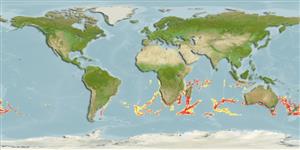>
Anguilliformes (Eels and morays) >
Synaphobranchidae (Cutthroat eels) > Synaphobranchinae
Etymology: Histiobranchus: Greek, istion, istos = sail + Greek, brangchia = gill (Ref. 45335).
More on author: Regan.
Environment: milieu / climate zone / depth range / distribution range
Ecología
marino bentopelágico; rango de profundidad 950 - 3001 m (Ref. 31334). Deep-water; 5°S - 48°S
South Atlantic, Indian and Pacific. Represented by at least two different geographical forms.
Tamaño / Peso / Age
Maturity: Lm ? range ? - ? cm
Max length : 62.8 cm TL macho / no sexado; (Ref. 31334); 67.0 cm TL (female)
Short description
Morfología | Morfometría
Radios blandos dorsales (total): 252-309; Radios blandos anales: 164 - 218; Vértebra: 122 - 134. Dorsal fin rays before anus 72-120; precaudal vertebrae 60-67 (usually 64-65); lateral line pores before anus 45-53 (Ref. 31334). Pectoral fins small.
A benthic species (Ref. 75154).
Life cycle and mating behavior
Madurez | Reproducción | Puesta | Huevos | Fecundidad | Larva
Karmovskaya, E.S. and N.R. Merrett, 1998. Taxonomy of the deep-sea eel genus, Histiobranchus (Synaphobranchidae, Anguilliformes), with notes on the ecology of H. bathybius in the eastern North Atlantic. J. Fish Biol. 53(5):1015-1037. (Ref. 31334)
IUCN Red List Status (Ref. 130435)
Threat to humans
Harmless
Human uses
Más información
Nombres comunesSinónimosMetabolismoDespredadoresEcotoxicologíaReproducciónMadurezPuestaAgregación para la puestaFecundidadHuevosEgg development
Age/SizeCrecimientoLength-weightLength-lengthLength-frequenciesMorfometríaMorfologíaLarvaDinámica larvariaReclutamientoAbundanciaBRUVS
ReferenciasAcuiculturaPerfil de acuiculturaRazasGenéticaElectrophoresesheritabilidadEnfermedadesProcesamientoNutrientsMass conversion
ColaboradoresImágenesStamps, Coins Misc.SonidosCiguateraVelocidadTipo de nataciónSuperficie branquialOtolitosCerebrosVisión
Herramientas
Special reports
Download XML
Fuentes de Internet
Estimates based on models
Preferred temperature (Ref.
123201): 2.1 - 3, mean 2.6 °C (based on 203 cells).
Phylogenetic diversity index (Ref.
82804): PD
50 = 0.6250 [Uniqueness, from 0.5 = low to 2.0 = high].
Bayesian length-weight: a=0.00071 (0.00031 - 0.00164), b=3.12 (2.92 - 3.32), in cm total length, based on LWR estimates for this (Sub)family-body shape (Ref.
93245).
Nivel trófico (Ref.
69278): 4.2 ±0.5 se; based on size and trophs of closest relatives
Fishing Vulnerability (Ref.
59153): Moderate to high vulnerability (47 of 100).
